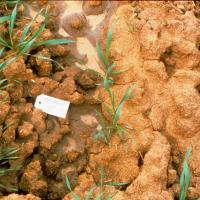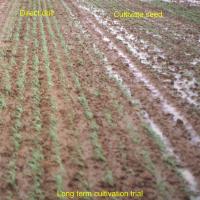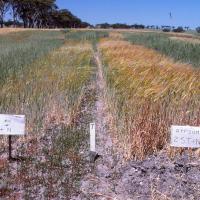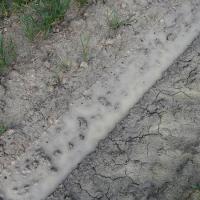Diagnosing poor seedbed soil structure
Poor seedbed soil structure impedes a seedling's ability to reach the surface and increases the risk of waterlogging. For example; dense hard-setting heavy soils are dense and poorly structured throughout the soil profile; better-structured heavy soils where cultivation has degraded topsoil structure.
What to look for
- Areas of crusted or dispersed soil with poor germination, and worse waterlogging after rain.
- Puddles that are "milky" from dispersed clay.
- Soil surface crusts that impede seedling emergence after wet dispersed soil dries.
Paddock
- Normal germination but reduced emergence due to soil crusting, cloddiness or waterlogged seedbed.
- Plants in very dense sodic or magnesic soils may have slower root and top growth.
- Delayed flowering of affected plants.
- Subsequent growth is normal unless there are subsoil constraints.
Plant
What else could it be
| Condition | Similarities | Differences |
|---|---|---|
|
Waterlogging, deep seeding and silly seedling
|
Can cause poor emergence and weak seedlings, and can be worsened by poor seedbed soil structure. | Poor seedbed soil structure is mainly a problem in heavy soils when the topsoil is crusted or dispersed. |
Where does it occur?
- Naturally sodic or magnesic soils such as moort soil common in the Great Southern, Lakes and Jerramungup districts, wandoo or mallee soils that often occur below breakaways.
- Many clay soils also have low organic matter levels and are readily degraded by cultivation.
- Cultivation or trampling of wet soil by livestock before significant pasture growth degrades soil structure.
- Heavy rain on unprotected soils can create a crust on poorly structured soil surface.
Management strategies

Spreading gypsum

Minimum tillage
- Management practices include: No-till crop establishment and improved stubble retention.
- Increasing soil organic matter with residue retention, green or brown manuring, or pasture ley.
- Gypsum and possibly lime application. Note that not all soils are responsive to gypsum and a response test is recommended.
- Compaction control or prevention.
- Loosening topsoil and subsoil in association with gypsum application and controlled traffic cropping (with or without raised beds).
- Avoiding heavy grazing during early winter and maintain sufficient cover during summer.
See also
Page last updated: Friday, 17 April 2015 - 2:07pm





